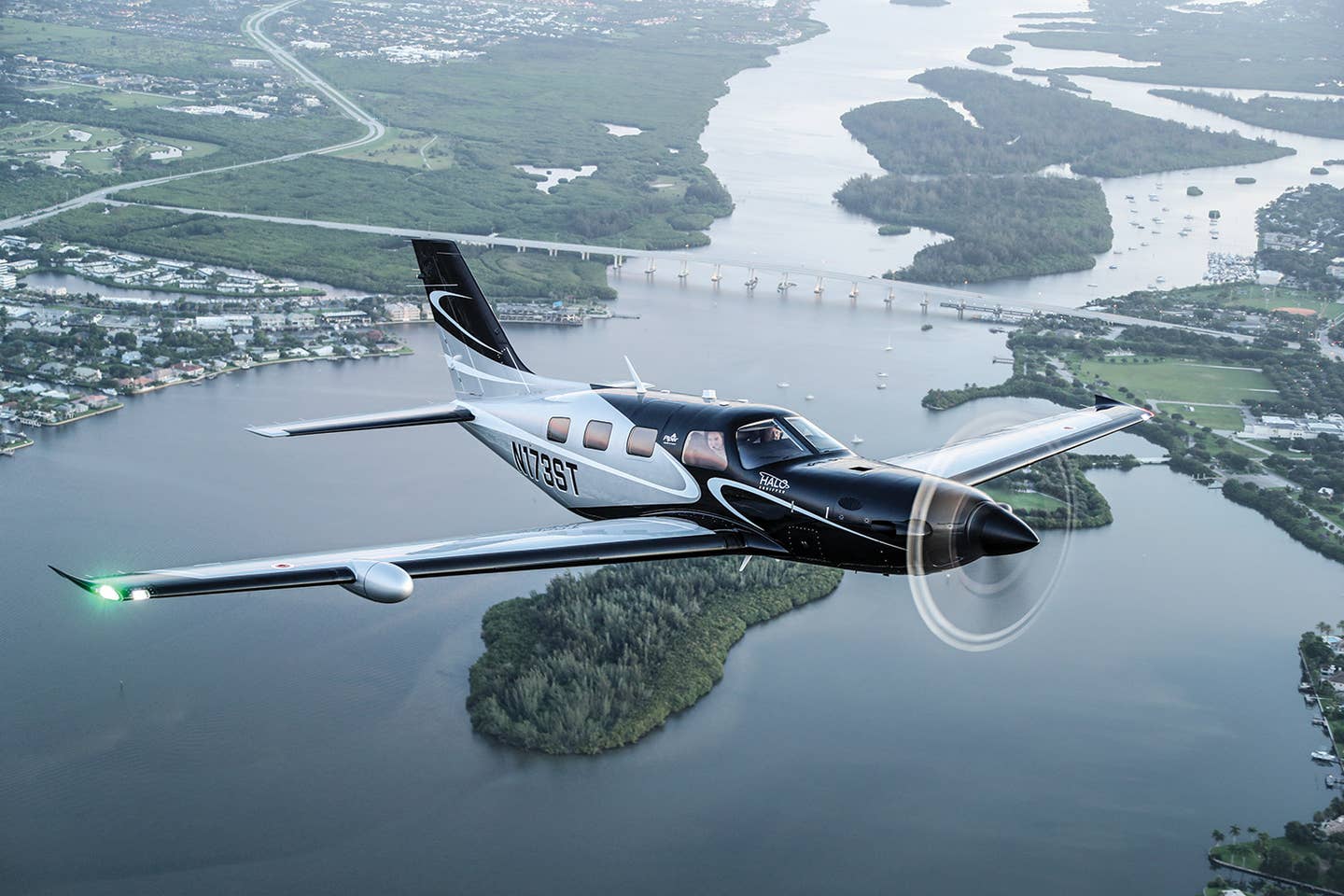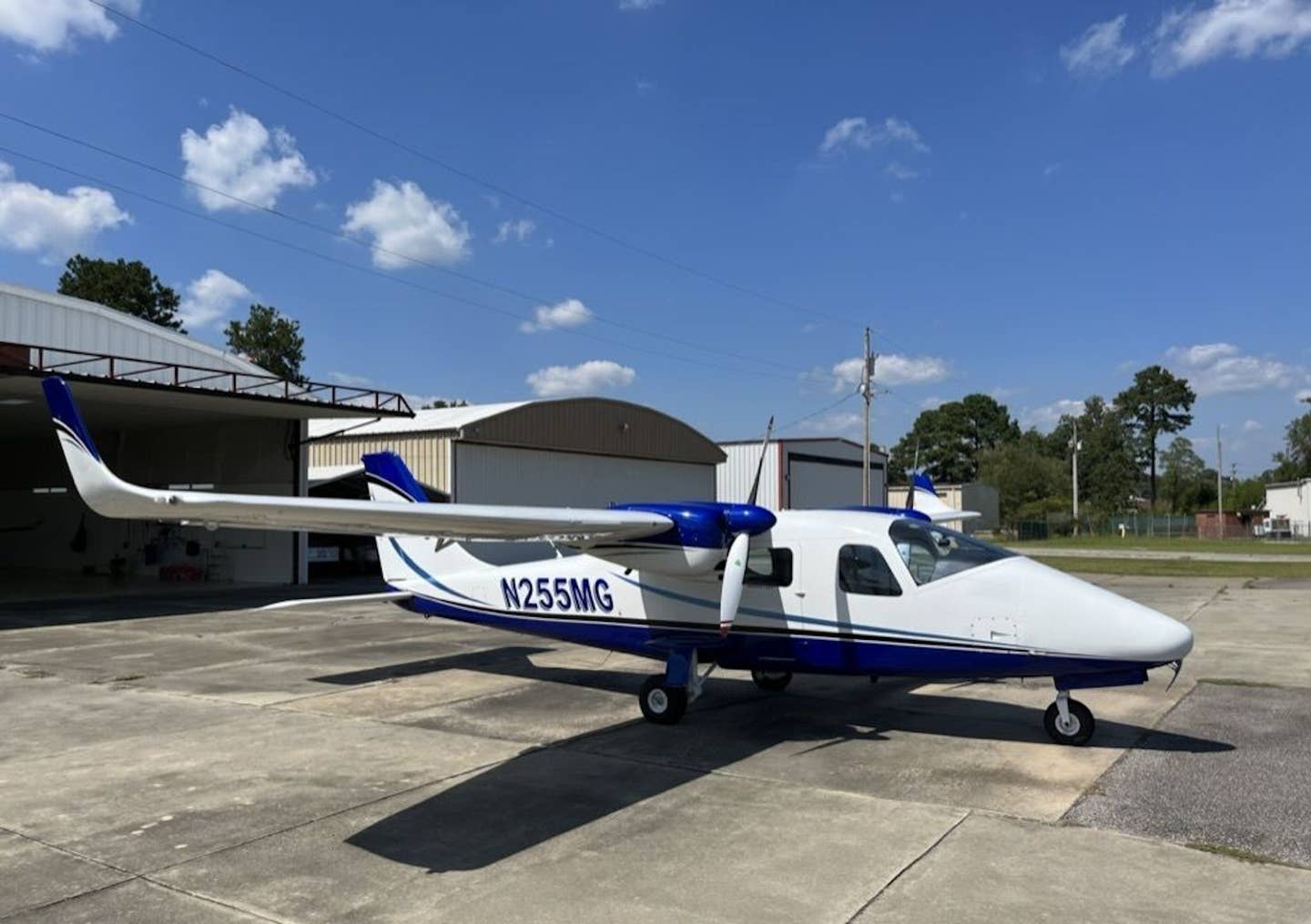
The five-blade composite Hartzell prop is an option that reduces vibration and adds performance and ramp appeal. Richard Maneen
Two larger-than-life FLYING covers grace the factory walls at the Piper Aircraft manufacturing facility in Vero Beach, Florida. The first, from March 2008, shows off the newly launched Piper Matrix, a nonpressurized version of the original PA-46 series made a little bit easier to manage by its relative lack of complexity, bringing a big-cabin feel to a single-engine piston airplane aimed precisely at the owner-pilot. The second, from March 2011, features a Piper Mirage looking as though it would power its way straight off the wall and through the hangar doors on the far end of the production line. The turboprop version of the Malibu, the Mirage went the other direction from the Matrix, bestowing its bigger performance numbers upon those pilots ready to step up.
The Piper M600 at a Glance
FLYING exclusive offer: 7 Day Free Trial + 10% off Conklin&deDecker turbine aircraft data.
Ten years later, the newest evolution of the PA-46 series—Piper’s M600/SLS Halo—proposes to do both, delivering an envelope of protection readily managed by transitioning pilots while at the same time upping the ante in speed and payload. When the M600 update to the M500 first arrived on the scene in 2016, those dream numbers—the result of 100 more horsepower up front from a flat-rated PT6A-42A engine—really came true.
This year, with the FLYING Innovation Award-winning Autoland from Garmin giving the M600 its Halo, Piper’s quest for an ever-higher level of GA safety got a serious boost. The folks at Garmin will tell you Autoland couldn’t have come to fruition without Piper, and the feeling is mutual. “The M600 SLS and its Halo Safety System with Autoland is the result of an unwavering commitment to safety as well as the desire to evolve our products based on market input,” said Piper president and CEO John Calcagno. “This standard feature brings peace of mind to pilots and their families.”
Chasing the Grail
When FLYING first flew the initial M600 in market-survey mode five years ago—just hours before the FAA signoff on the type—we had a sense the PA-46 series had found its sweet spot, and the type has achieved great success. For the photo shoot for this article, we captured serial No. 173 in flight over the Atlantic Ocean, and I flew my demo flight in serial No. 163, currently in experimental mode, to test out several new goodies on board. Piper delivered 36 of the PA-46-600TP M600/SLS aircraft in 2020 and six in the first quarter of this year, to make a reported total of 161 out the door since its debut—with clearly more in the immediate pipeline.
Handling characteristics and performance make it comparable in some ways to half a Beechcraft King Air 200, according to pilots we talked with for this report. When Piper moved from the M500 to the M600, the extra 100 shp coaxed from the Pratt & Whitney PT6-series engines made all the difference in the world. In this case, they are the same 42s you find on King Air 200s from the early 2000s, but on the King Airs, they’re rated at 850 shp per side, while the M600 offers 600 shp. In the air, the M600′s wing makes it respond like the larger airplane, and the climb rate as high as 3,000 fpm stacks up well against the turboprop twin as well. Add in a range while carrying five passengers with light bags (a total of 1,000 pounds) of up to 800 nm—and the fact that it sips half the gas—this makes the M600/SLS a compelling choice for owners who fit that use case.
A Protective Halo
The Halo-equipped M600/SLS debuted with Garmin’s Autoland as the premier feature in the model’s standard lineup beginning in 2020. But the well-rounded roster of capabilities that Autoland and its accompanying avionics, known collectively as Autonomi, pack onto the turboprop make it just part of an overall “safety system,” as Piper calls it.
To recap, in case you aren’t familiar with Autoland: The orchestrated suite of software and hardware directs the airplane to the nearest suitable airport in the event of pilot incapacitation. It does so by controlling the aircraft’s navigation, descent, weather and terrain avoidance, gear extension, flight-into-known-icing activation, flaps, braking, and all communication with ATC. While it’s designed for passengers to initiate with a guarded button on the panel, the pilot can start the sequence via that same button, or the airplane can initiate Autoland itself if the pilot is unresponsive in certain cases.
Hypoxia recognition incorporated into the emergency descent mode takes it one step further, monitoring the pilot any time they engage the autopilot above 14,000 feet msl. If the pilot is unresponsive to the system’s prompts, EDM will bring the airplane below 14,000 feet. After that descent, the system will initiate the Autoland sequence if no further response comes from the pilot after a set period of time.
Halo also includes Garmin’s electronic stability and protection, synthetic vision, SafeTaxi, TerminalTraffic (which syncs with ADS-B-equipped aircraft and ground vehicles), SurfaceWatch (directing you to the runway before takeoff and to the ramp after landing), Flight Stream 510 to create a Bluetooth connection between the aircraft and your mobile device, and an autothrottle system.
I flew the model Piper currently has in experimental/market-survey status, N163HL, specifically so I could test out the latest update to the Garmin autothrottle that was originally incorporated into the M600 for Autoland. With the upcoming approval, the pilot can use the autothrottle outside of the Autoland sequence. And as tested, the A/T certainly does its part to assist the pilot—but more on that a bit later.
Preflight to Approach
Both models observed for this report feature the optional five-blade Hartzell composite propeller, approved in spring 2017, which—other than looking completely badass on the ramp—delivers an improved vibration signature inside the airplane, as well as likely better takeoff and climb performance, though no concrete numbers have been established by Piper. The steel-shank core is wrapped in carbon composite material and trimmed with a nickel-cobalt leading edge with a mesh erosion screen to protect the blades from foreign-object debris. That’s important because a single nick on the blade renders it unairworthy. As we noted on my preflight walk-around with Piper Aircraft business development director Dan Lewis, a stray drop of rain clinging to the leading edge can look an awful lot like a chip out of that blade. We were both relieved when it wiped off. That said, the propeller carries a lifetime guarantee, the result of a blade strength between five and 10 times that of blades with wood cores. Continuing on the walk-around, a hidey-hole-size compartment under a circular access panel near the horizontal stab can retain towels, testers and other cleaning accoutrements.
The fuselage could do with a few more inches in the cross section—a common refrain from those who will need to sit knee-to-knee with their fellow passengers in the back. I’m a not a large human, but it still took nimble maneuvering to drop myself into the left seat. Once settled into the flight deck, though, the M600 feels like a real front office, with a well-thought-out panel, easy-to-reach circuit breakers, and electrical-system controls on the overhead immediately in front of the pilot.
While taxiing, the rudder pedals remain a bit stiff, but the flight controls improve greatly in feel once you’re airborne. In fact, the relatively moderate pitch force in comparison to the slightly heavier aileron response reminded me of being in a stretched Bonanza with a longer wing. The same nose-heavy profile on landing will also echo that of a front-loaded A36, especially with two or three people placed towrds the front, and light baggage.
My introduction to the stand-alone autothrottle began in its takeoff setting, which comes on line as the powerplant reaches 700 pounds of torque. It felt like we were just getting started down the runway when the autothrottle captured the lever under my guiding hand. I continued steering, but the autothrottle set the Pratt & Whitney out front to the most efficient takeoff power setting and held it there as I came through 85 knots and rotated.
The climb from nearly sea level to 14,500 feet—above the lifting condensation level, its commensurate clouds and bumps, and general coastal fray—zoomed along at a variable rate between 2,500 and 3,000 fpm, with the total climb completed in less than six minutes on the G3000′s clock. With a couple of clearing turns in the last part of the climb, I agreed with the prior assessment that the airplane’s coupling is not unlike that of its larger brethren.
At 14,500 feet, I disconnected the A/T, which had held us at the maximum efficient torque setting throughout the climb, and Lewis walked through the M600′s protective features that predated the Halo version: electronic stability and protection and underspeed protection. Added since we previously flew the M600 in 2016 is overspeed protection, an addition to the emergency-descent-management protocol first installed with the G3000 in the model that year. During the overspeed-protection sequence, I watched and listened as the airspeed approached the top end, and when it rolled past 248 knots, a voice announced, “Autothrottle,”—which was already engaged from the takeoff and climb—and the power lever moved as the system adjusted the torque to a lower setting to keep us from blasting through the invisible speed wall.
With all of the envelope protection baked into the M600, it’s important to note the ability to override all of it in the event an evasive maneuver is required. That tough wing is responsible in part for a green arc (73 kias to 251 kias) on the tape that goes all the way up to the barber pole at 251 kias, the VNO.
- CHECK OUT MORE AIRCRAFT REVIEWS: We Fly
That said, it almost felt like a setup when things played out as they did when we headed back toward the airport. Upon descending down to 4,000 feet to duck below a scattered cumulus layer and line up for an approach into Vero, Lewis called out, “Skydiver!” and gestured out to the front of the airplane. Sure enough, there was a canopy at 12 o’clock and well inside our traffic bubble. I hit a 30-degree bank left to avoid the person hanging in the straps, only to see another canopy come through my field of view. I banked harder and pressed the autopilot-disengage button on the yoke to release the ESP, which would have resisted my momentary bank past 45 degrees to steer clear of the skydiver.
“The autothrottle will catch you a little faster than the system [alone] will,” says product marketing manager Bryant Elliott. “It will start increasing power before that underspeed kicks in. So, if the autothrottle is not engaged, the airspeed at which the underspeed is captured will be a bit lower.” The upshot? The enhanced aircraft flight-control system, launched with the M500 and M350 in 2015, now has another layer of protection.
When you look at what Garmin has been working on all along, they just needed a way to tie all the systems together to create Autoland. The Garmin GFC 700 has been able to fly an approach all the way to the ground the whole time; it just needed a way to extend the gear and flaps and flare and brake correctly.
Angels in the Panel
Up front, you can configure the screens to display any way you want—except maybe the latest Netflix movie—including full-screen PFDs on the left and right with traffic and map insets, as well as a split screen on all three displays featuring large-scale versions of pages such as weather, terrain or the engine-indication system. The big screens are driven by a pair of GTN 850s positioned side by side vertically on the center console above the power quadrant.
The daily summer thunderstorms had yet to kick up along the Treasure Coast during our demo flight, so we couldn’t find much to scope on the onboard radar. The M600 included the standard Garmin GWX 75 with an optional enhancement package—this option is now the newly rebranded Garmin GWX 8000 (previously the GWX 80). When the M600 debuted, its clean-sheet wing streamlined the radar pod into the leading edge of the right wing, improving ground clearance and allowing for a wider gear stance by a couple of inches on each side. The result of the change to the main gear is improved crosswind handling, with a demonstrated limit of 17 knots. “Ground clearance was not really an issue—it was getting the radar away from the fuselage,” Elliott said. The false feedback from the propeller went away with the change.
The GWX 8000 brings large-aircraft radar capability to the owner-flown market. Primary among its features is StormOptix. As Elliott noted: “Piper has offered the ground-clutter suppression and turbulence detection since the launch of the GWX 75, but the additional Auto Mode and volumetric scanning are unique to the GWX 8000. Also, the volumetric scanning provides advanced ground-clutter suppression and advanced turbulence detection, as well as zero blind range,” which means that returns are maintained in the system’s memory, enabling them to be presented on the screen until they are essentially zero nautical miles away.
Placing the GWX 8000 into auto mode activates the three-dimensional volumetric scanning with automatic adjustment of the antenna sweep to create a picture of the scanned volume. Those of us who recall single-color onboard radar (often a ghostly green) will be blown away by the 16-color palette available on the new display. Because of the diameter of the antenna, the wind-shear option is not available in the M600—but other enhancements, such as predictive hail and lightning, will be available with future software loads.
Backup instrumentation is now provided by the Garmin GI 275 integrated flight display, with its smaller, round-dial presentation, taking the place of the Aspen Avionics Evolution PFD.
One area where the M600 shines is in operational cost: That figure runs roughly $750 per hour according to the Aircraft Cost Calculator. How does this compare to other single-engine turboprops in the lineup? Though steep in comparison to piston-powered, high-performance singles, it ranks well among its peers in the single-engine-turboprop class, with the M600 besting the Daher TBM 940 and Pilatus PC-12 NG by nearly $200 per hour—and about $50 less per hour than the Epic E1000. Granted, with each of those competitors, you gain carrying capability and speed in varying amounts.
The new black-and-silver paint schemes manage to look both cool on the ramp and hot in the air. Interiors have had an update as well, with the EXP package now standard in the M600/SLS. But it’s more than an illusion of comfort and protection that the cabin environment provides. With the FLYING Innovation Award-winning Halo quietly standing by, the pilot now has the ability to give their passengers a true safety net of their own.
Piper M600/SLS Halo Statistics
| Price (as tested): | about $3.12 million | Max Takeoff Weight: | 6,000 lb. |
| Engine: | Pratt & Whitney PT6A-42 | Max Landing Weight: | 6,000 lb. |
| Propeller: | Hartzell five-blade composite | Baggage Compartment (aft): | 100 lb. |
| Horsepower: | 600 shp, flat-rated | Useful Load: | 2,400 lb. |
| Seats: | 6 | Max Usable Fuel: | 260 gal. |
| Length: | 29 ft., 8 in. | Max Operating Altitude: | 30,000 ft. |
| Height: | 11 ft., 4 in. | Max Rate of Climb: | 3,000 fpm |
| Cabin Height: | 3 ft., 11 in. | Max Cruise Speed: | 274 ktas |
| Cabin Width: | 4 ft., 2 in. | Max Range: | 1,658 nm at 245 kias, ISA, MTOW, no wind, 45-min. reserve |
| Wingspan: | 43 ft., 2 in. | VNO: | 251 knots |
| Power Loading: | 10 lb./hr. | Stall Speed, Landing Configuration, MTOW: | 62 kias |
| Wing Loading: | 28.71 lb./sq. ft. | Takeoff Distance Over 50 Ft. Obs: | (ISA, sea level) 2,635 ft. |
| Standard Empty Weight: | 3,250 lb. | Landing Distance Over 50 Ft. Obs: | (ISA, sea level) 2,659 ft. |
The Right Training
An accident claimed a Piper M600—but fortunately not its pilot—in a runway-excursion event earlier this year. The preliminary report from the National Transportation Safety Board points to the pilot’s low time in type. Interviews with the broker who sold him the airplane indicate that the pilot’s low total time and laissez-faire approach to the type-specific training offered by Piper may have contributed to the airframe’s demise.
Piper offers a five-day transition course to the M600 through its partner, Legacy Flight Training at Vero Beach and Scottsdale, Arizona. And though the training in type is important, it’s also worth noting that the PA-46 series puts pilots into the midlevels (between FL 160 and FL 300) often for the first time. This means flying a fast, pressurized aircraft above some of the weather, but not all. It means exposure to high-altitude flying above FL 250—and getting the requisite training if you go there. It means more exposure to in-flight icing. These conditions are all straightforward enough to handle while everything is going well, but once a chain of events links up, experience up here can be a swift and harsh teacher. In the nonturbine PA-46s, flight in the midlevels required precise engine management, somewhat ameliorated by the altitude-happy PT6A.
This story appeared in the September 2021 issue of FLYING Magazine

Subscribe to Our Newsletter
Get the latest FLYING stories delivered directly to your inbox






